Finite Integration Method with Chebyshev Expansion for Shallow Water Equations over Variable Topography
Abstract
1. Introduction
2. Developed FIM-CPE
- (i)
- The zeros of the Chebyshev polynomial for are given by
- (ii)
- The single-layer integrals of the Chebyshev polynomial are given for by
- (iii)
- The Chebyshev matrix at each zero defined in (4) is given byIts multiplicative inverse is .
- (i)
- Let , and denote an identity matrix. Then,
- (ii)
- Let , , , and . Then,
- (iii)
- Let and . Let be an standard unit vector with a 1 in the i-th position and 0s elsewhere, i.e., . If an permutation matrix is defined as , then .
2.1. One-Dimensional Chebyshev Integration Matrix
2.2. Two-Dimensional Chebyshev Integration Matrix
- Type I: If is fixed but is varied, (11) becomes , where is an element of the Chebyshev integration matrix at position . By varying all , we obtain the block matrix:This is denoted by .
- Type II: If is fixed but is varied, (11) becomes , where is an element of the Chebyshev integration matrix at position . By varying all , we obtain the block matrix:This is denoted by for the local numbering system. We can transform it globally by employing the aforementioned permutation matrix , defined in (10). Then, we obtainHence, we conclude from both types I and II that .
3. One-Dimensional SWEs
3.1. Numerical Algorithm for One-Dimensional SWEs
| Algorithm 1 Numerical algorithm for solving the one-dimensional SWEs via FIM-CPE |
| Input: a, b, M, T, , , , , and CFL.
Output: The numerical solutions and at time T.
|
3.2. Discussion on Theoretical Foundations for One-Dimensional SWEs
- Stability: The stability of the numerical algorithm is primarily governed by the time-stepping component. For the explicit forward difference scheme used for temporal discretization, stability is ensured by adhering to the CFL condition. This condition, standard for hyperbolic systems like the SWEs, requires the time step to be dynamically adjusted to prevent numerical instabilities, ensuring that waves do not travel more than one spatial grid cell per time step. Our algorithm strictly implements this condition in every iteration to maintain a stable simulation.
- Accuracy and Convergence: The high accuracy of the FIM-CPE method stems from its two core components. First, the use of Chebyshev polynomial expansion for spatial approximation provides spectral accuracy for smooth functions, leading to very low approximation errors. Second, by transforming the partial differential equations into integral equations, the method avoids direct numerical differentiation and is thus less sensitive to the round-off errors that can affect traditional finite difference methods. For a well-posed problem, a stable and consistent scheme will converge. The method’s demonstrated stability and high accuracy provide strong evidence for its convergence, while a formal proof remains a direction for future research.
3.3. Numerical Simulations for One-Dimensional SWEs
3.4. Convergence Analysis
4. Two-Dimensional SWEs
4.1. Numerical Algorithm for Two-Dimensional SWEs
- Scenario I: When y is held constant and x is the free variable, we havewhere , is an Chebyshev matrix as defined in Lemma 1(iii) and . Substituting the zeros of the Chebyshev polynomial , i.e., , into (39) yieldsThis simplifies to , where is an identity matrix.
- Scenario II: When x is held constant and y is the free variable, we havewhere , is an Chebyshev matrix as defined in Lemma 1(iii) and . Substituting the zeros of the Chebyshev polynomial , i.e., , into (40) yieldsThis simplifies to , where is an identity matrix and is a permutation matrix defined by (10).
- The left and lower boundary conditions for at time are obtained by replacing and into (37) and (38), respectively:where , , and .
- The right and upper boundary conditions for at time are obtained by replacing and into (37) and (38), respectively:where with M entries, , with N entries and .
- The right and upper boundary conditions for at time over the odd position corresponding to and zeros in X and Y, respectively, are obtained by substituting and into (37) and (38), respectively, and left-multiplying by from (45):where is an odd extraction, , is an odd extraction, and .
- The left and lower boundary conditions for at time over the even positions corresponding to and zeros in X and Y, respectively, are obtained by replacing and into (37) and (38), respectively, and left-multiplying by from (46):where is an even extraction, , is an even extraction, and .
| Algorithm 2 Numerical algorithm for solving the two-dimensional SWEs via FIM-CPE |
| Input: a, b, c, d, M, N, T, , , , , , and CFL. Output: The numerical solutions , and at time T.
|
4.2. Discussion on Theoretical Foundations for Two-Dimensional SWEs
- Stability: Stability in the two-dimensional scheme is also maintained by enforcing the CFL condition, which is adapted to account for velocities and grid spacing in both spatial dimensions, as defined in Algorithm 2. A formal stability proof would require analyzing the spectral properties of the much larger amplification matrix, which involves the Kronecker products of the integration matrices and .
- Accuracy and Convergence: The high accuracy of the two-dimensional scheme is derived from the use of two-dimensional Chebyshev polynomial expansions. The finite integration approach continues to minimize round-off errors. As with the one-dimensional case, the combination of a stable and consistent scheme supports convergence. A rigorous mathematical proof for the two-dimensional nonlinear system is a complex topic and reserved for future theoretical investigation.
4.3. Numerical Simulations for Two-Dimensional SWEs
5. Conclusions
Author Contributions
Funding
Data Availability Statement
Acknowledgments
Conflicts of Interest
Abbreviations
| CFL | Courant–Friedrichs–Lewy |
| FDM | finite difference method |
| FIM-CPE | finite integration method with Chebyshev polynomial expansion |
| FVM | finite volume method |
| MAE | mean average error |
| PDE | partial differential equation |
| SBP-SAT | summation-by-parts operators with simultaneous approximation terms |
| SDM | spectral difference method |
| SWE | shallow water equation |
References
- De St Venant, B. Theorie du mouvement non-permanent des eaux avec application aux crues des rivers et a l’introduntion des Marees dans leur lit. Comptes Rendus Acad. Sci. 1871, 73, 148–154. [Google Scholar]
- Valiani, A.; Caleffi, V.; Zanni, A. Case study: Malpasset dam-break simulation using a two-dimensional finite volume method. J. Hydraul. Eng. 2002, 128, 460–472. [Google Scholar] [CrossRef]
- George, D.L. Finite Volume Methods and Adaptive Refinement for Tsunami Propagation and Inundation; University of Washington: Seattle, WA, USA, 2006. [Google Scholar]
- Mignot, E.; Paquier, A.; Haider, S. Modeling floods in a dense urban area using 2D shallow water equations. J. Hydrol. 2006, 327, 186–199. [Google Scholar] [CrossRef]
- Gunawan, H.P. Numerical Simulation of Shallow Water Equations and Related Models. Ph.D. Thesis, Université Paris-Est, Champs-sur-Marne, France, 2015. [Google Scholar]
- Sarkar, B.; De, S. Oblique wave diffraction by a bottom-standing thick barrier and a pair of partially immersed barriers. J. Offshore Mech. Arct. Eng. 2023, 145, 010905. [Google Scholar] [CrossRef]
- Mekchay, K.; Pongsanguansin, T.; Maleewong, M. Numerical Methods Based on Discontinuous Galerkin and Finite Volume Methods for Shallow Water Model and Applications. Ph.D. Thesis, Chulalongkorn University, Bangkok, Thailand, 2016. [Google Scholar]
- Hudson, J. Numerical Techniques for the Shallow Water Equations; University of Reading, Department of Mathematics: Reading, UK, 1999. [Google Scholar]
- Crowhurst, P.; Li, Z. Numerical solutions of one-dimensional shallow water equations. In Proceedings of the 2013 UKSim 15th International Conference on Computer Modelling and Simulation, Cambridge, UK, 10–12 April 2013; IEEE: Piscataway, NJ, USA, 2013; pp. 55–60. [Google Scholar]
- Peng, S.H. 1D and 2D Numerical Modeling for Solving Dam-Break Flow Problems Using Finite Volume Method. J. Appl. Math. 2012, 2012, 489269. [Google Scholar] [CrossRef]
- LeVeque, R.J. Balancing source terms and flux gradients in high-resolution Godunov methods: The quasi-steady wave-propagation algorithm. J. Comput. Phys. 1998, 146, 346–365. [Google Scholar] [CrossRef]
- San, O.; Kara, K. High-order accurate spectral difference method for shallow water equations. Int. J. Res. Rev. Appl. Sci. 2011, 6, 41–54. [Google Scholar]
- Lundgren, L. Efficient Numerical Methods for the Shallow Water Equations. Master’s Thesis, Uppsala University, Uppsala, Sweden, 2018. [Google Scholar]
- Boonklurb, R.; Duangpan, A.; Treeyaprasert, T. Modified finite integration method using Chebyshev polynomial for solving linear differential equations. J. Numer. Anal. Ind. Appl. Math. 2018, 12, 1–19. [Google Scholar]
- Boonklurb, R.; Duangpan, A. Finite Integration Method Using Chebyshev Expansion for Solving Nonlinear Poisson Equations on Irregular Domains. J. Numer. Anal. Ind. Appl. Math. 2020, 14, 7–24. [Google Scholar]
- Boonklurb, R.; Duangpan, A.; Saengsiritongchai, A. Finite integration method via Chebyshev polynomial expansion for solving 2-D linear time-dependent and linear space-fractional differential equations. Thai J. Math. 2020, 103–131. [Google Scholar]
- Duangpan, A.; Boonklurb, R. Numerical solution of time-fractional Benjamin-Bona-Mahony-Burgers equation via finite integration method by using Chebyshev expansion. Songklanakarin J. Sci. Technol. 2021, 43. [Google Scholar]
- Zhang, H.; Ding, F. On the Kronecker Products and Their Applications. J. Appl. Math. 2013, 2013, 296185. [Google Scholar] [CrossRef]
- Cyganek, B. Object Detection and Recognition in Digital Images: Theory and Practice; John Wiley & Sons: Hoboken, NJ, USA, 2013. [Google Scholar]
- Stoker, J.J. Water Waves: The Mathematical Theory with Applications; Courier Dover Publications: New York, NY, USA, 2019. [Google Scholar]
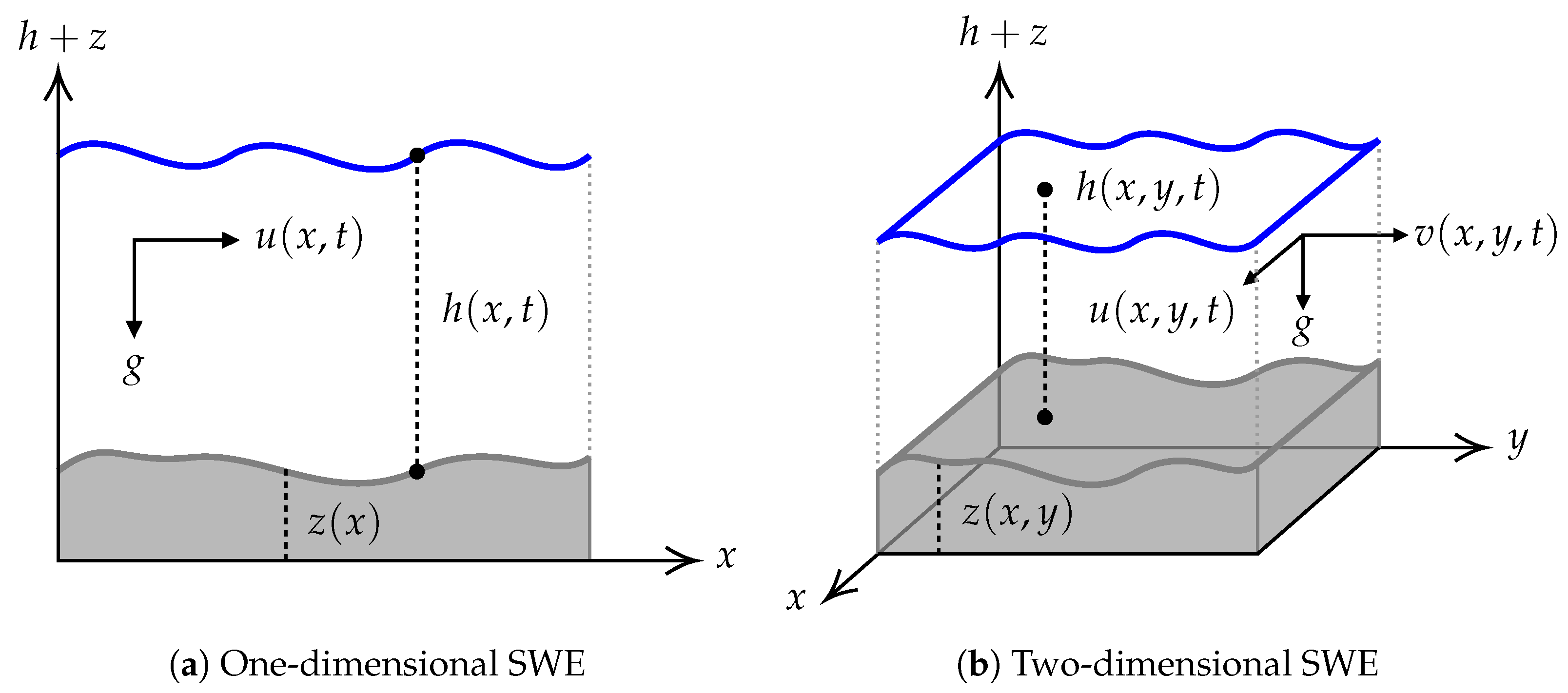
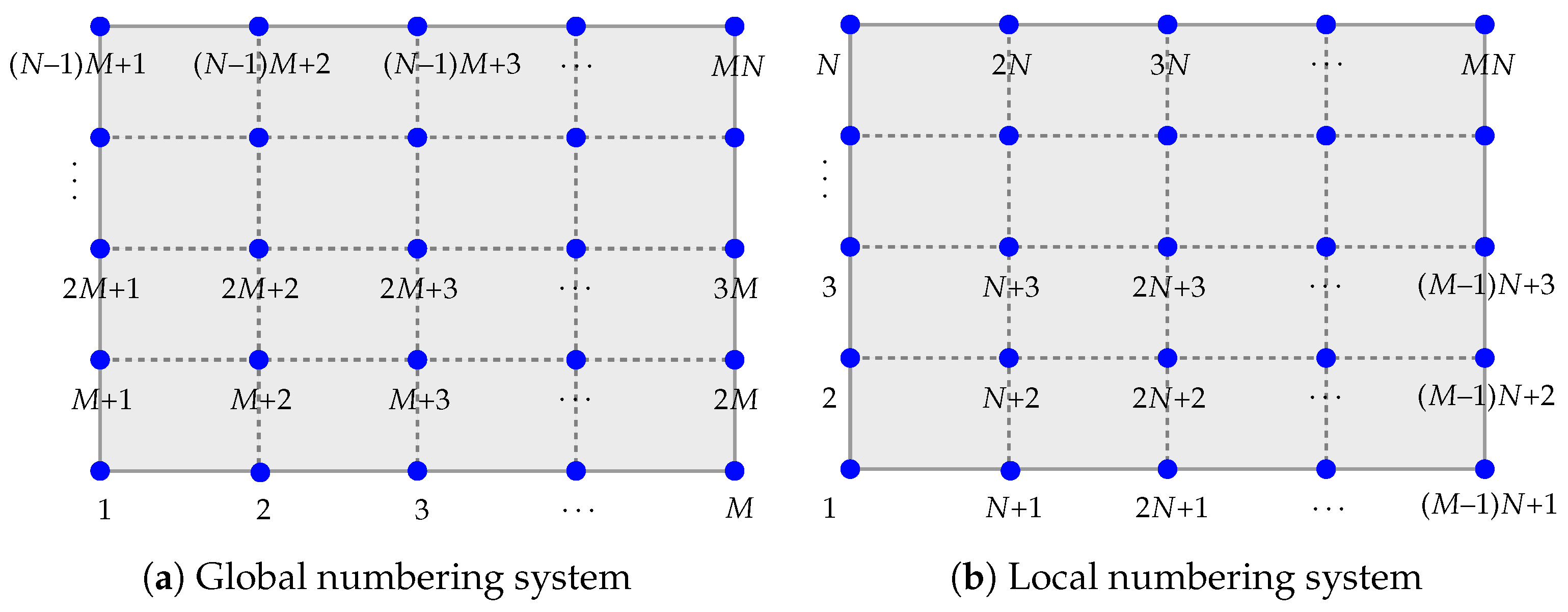
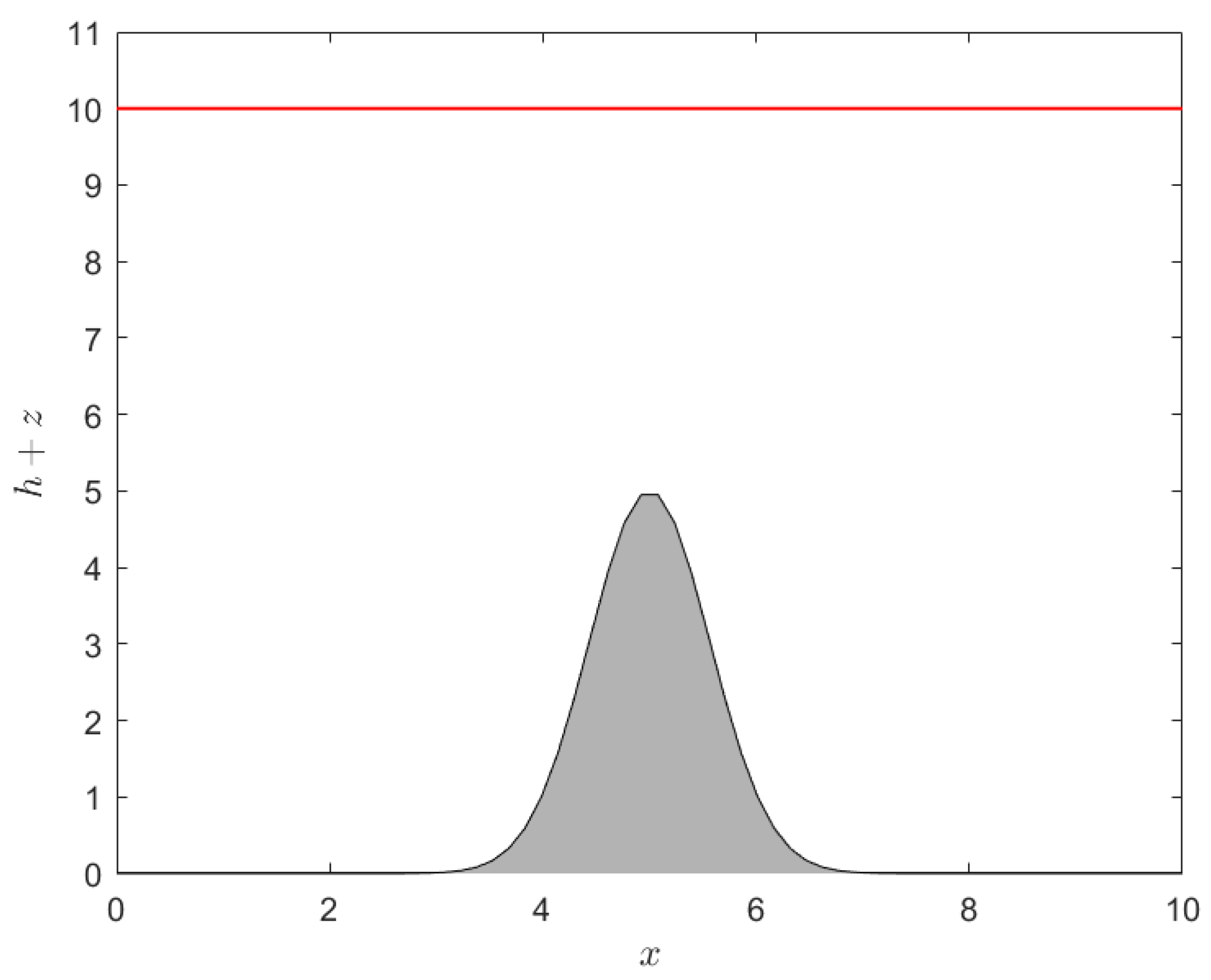


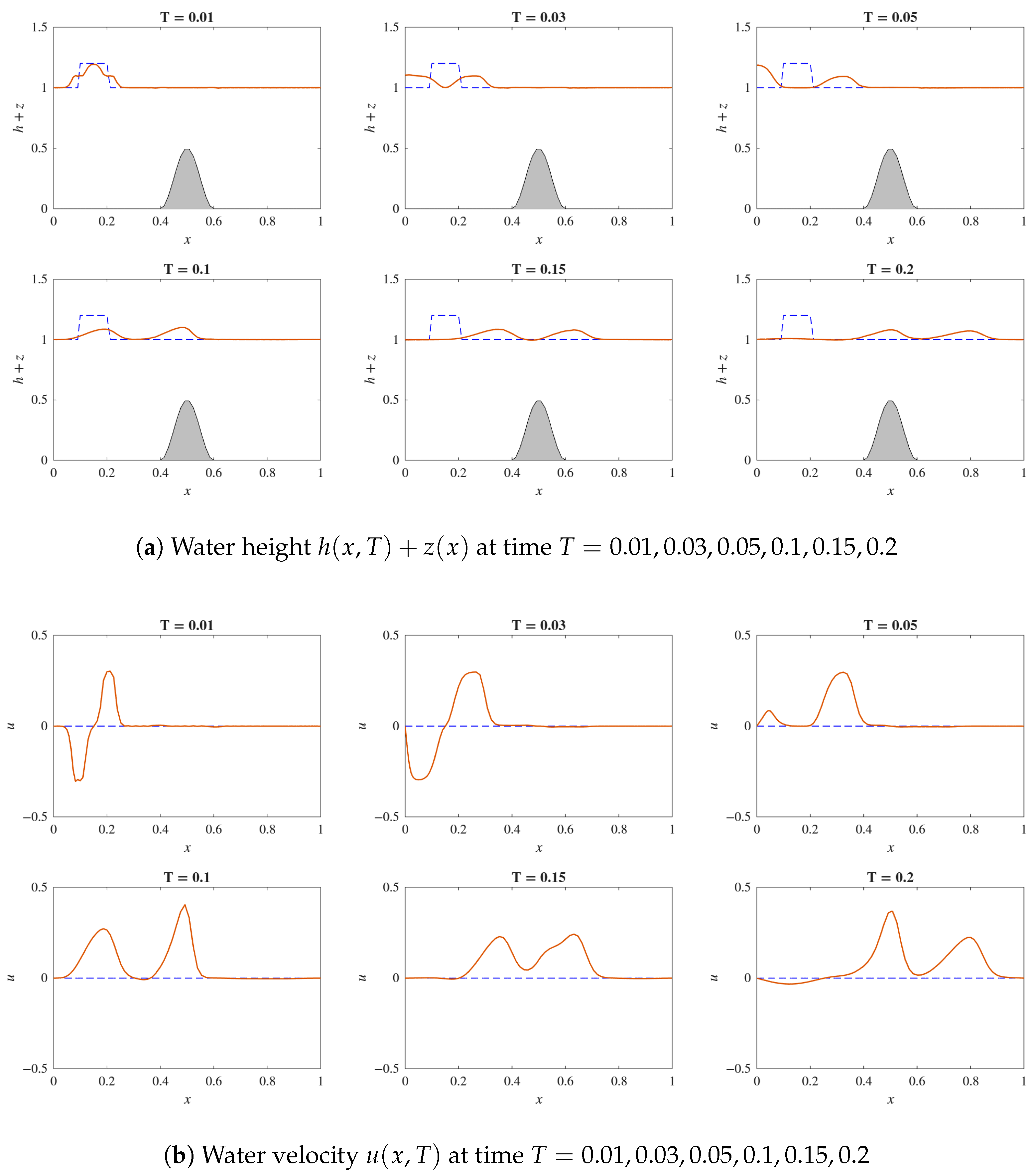
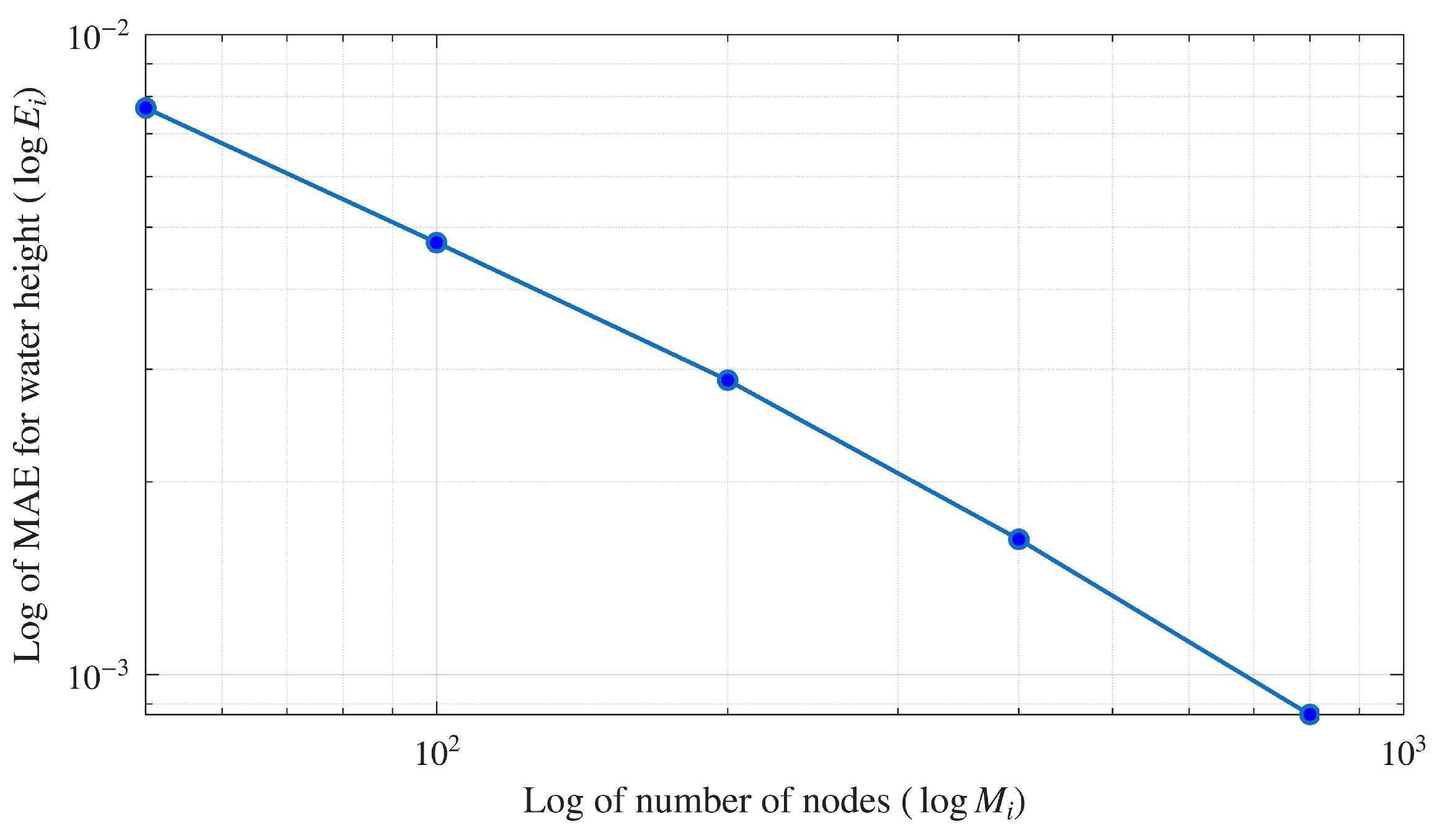
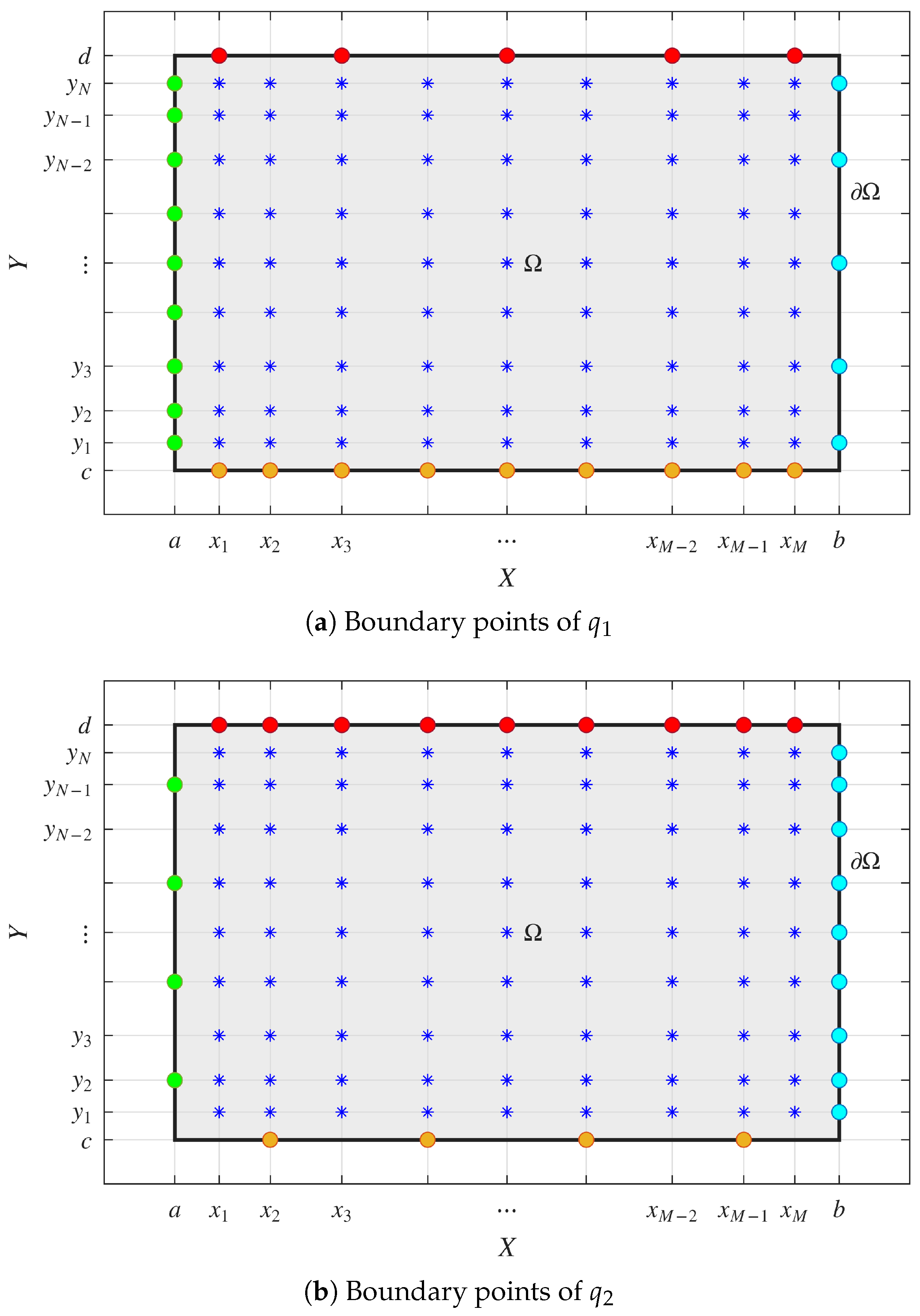
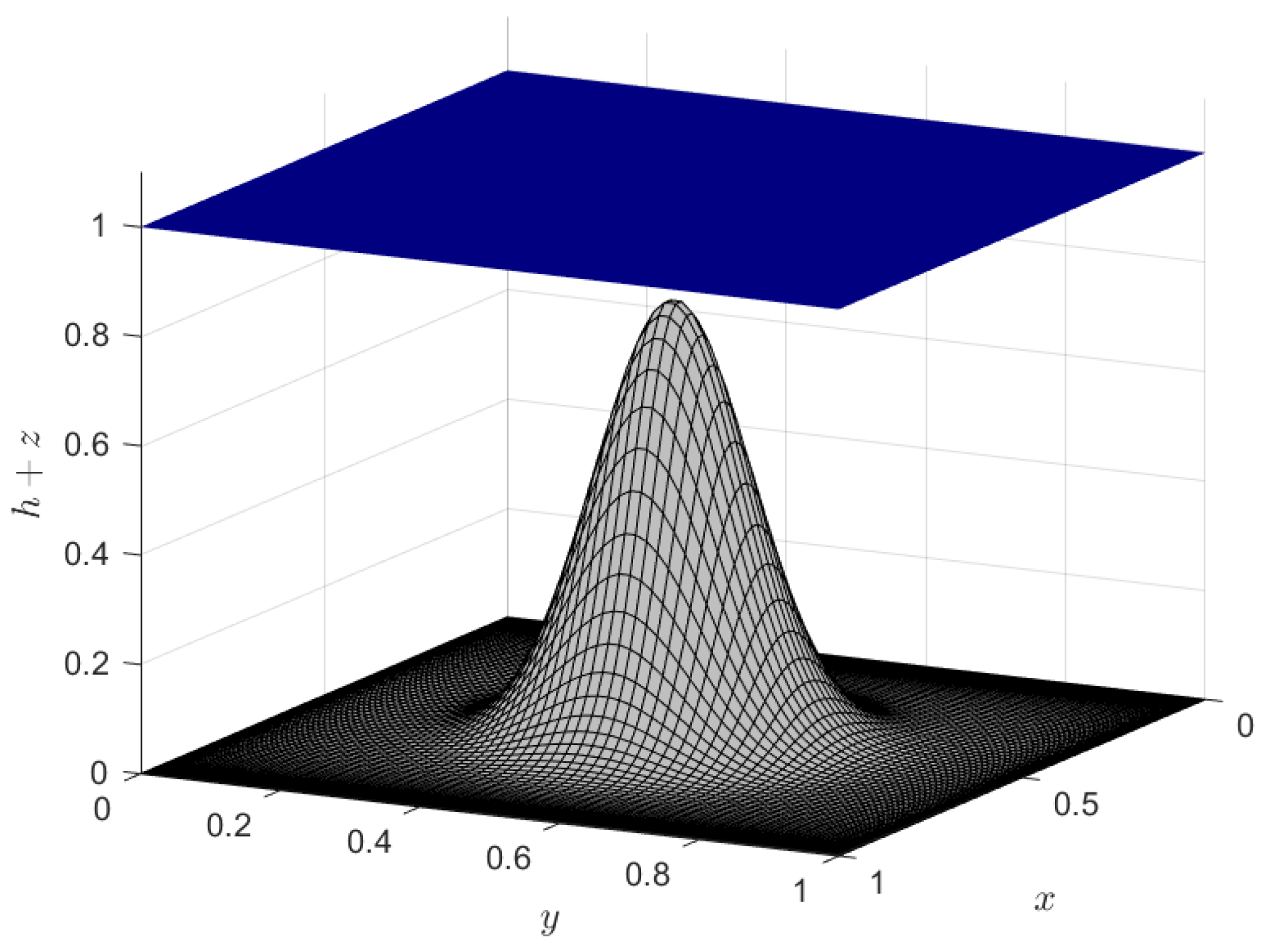
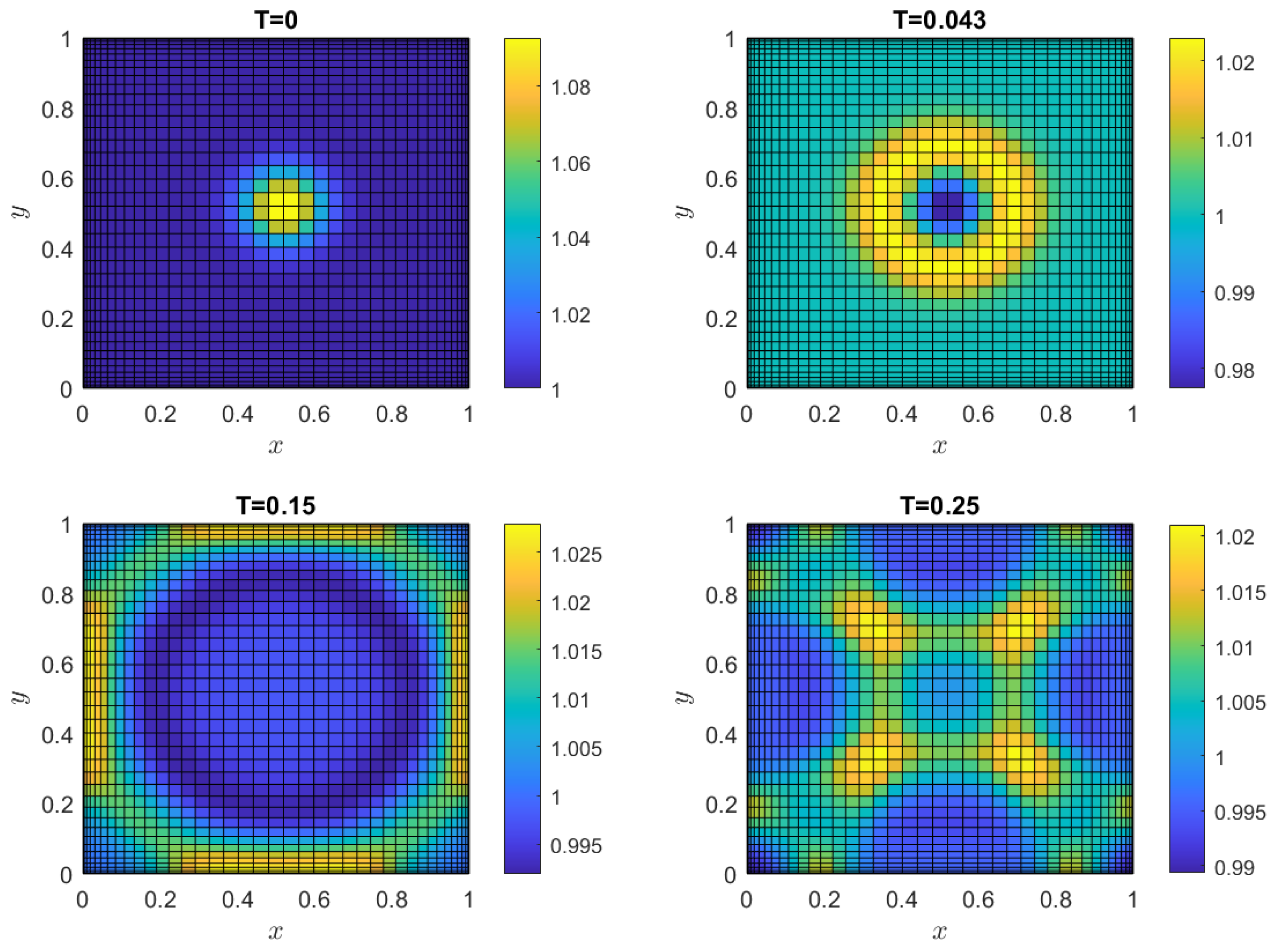
| M | FDM [8] | Algorithm 1 | Run Time (s) | ||
|---|---|---|---|---|---|
| 100 | |||||
| 200 | |||||
| 300 | |||||
| 400 | |||||
| Index i | Number of Nodes | MAE for Water Height | Order of Convergence |
|---|---|---|---|
| 1 | 50 | - | |
| 2 | 100 | 0.6992 | |
| 3 | 200 | 0.7142 | |
| 4 | 400 | 0.8257 | |
| 5 | 800 | 0.9105 |
| Example | Problem Description | Dim. | Nodes | MAE (Height) | MAE (Velocity) |
|---|---|---|---|---|---|
| 1 | Lake at Rest | 1D | 100 | ||
| 2 | Gaussian Pulse | 1D | 60 | Reaches steady state * | |
| 3 | Dam Break (Flat) | 1D | 200 | ||
| 4 | Dam Break (Bump) | 1D | 100 | Qualitative match † | |
| 5 | Lake at Rest | 2D | |||
| 6 | Gaussian Pulse | 2D | Qualitative match ‡ | ||
Disclaimer/Publisher’s Note: The statements, opinions and data contained in all publications are solely those of the individual author(s) and contributor(s) and not of MDPI and/or the editor(s). MDPI and/or the editor(s) disclaim responsibility for any injury to people or property resulting from any ideas, methods, instructions or products referred to in the content. |
© 2025 by the authors. Licensee MDPI, Basel, Switzerland. This article is an open access article distributed under the terms and conditions of the Creative Commons Attribution (CC BY) license (https://creativecommons.org/licenses/by/4.0/).
Share and Cite
Duangpan, A.; Boonklurb, R.; Apisornpanich, L.; Sutthimat, P. Finite Integration Method with Chebyshev Expansion for Shallow Water Equations over Variable Topography. Mathematics 2025, 13, 2492. https://doi.org/10.3390/math13152492
Duangpan A, Boonklurb R, Apisornpanich L, Sutthimat P. Finite Integration Method with Chebyshev Expansion for Shallow Water Equations over Variable Topography. Mathematics. 2025; 13(15):2492. https://doi.org/10.3390/math13152492
Chicago/Turabian StyleDuangpan, Ampol, Ratinan Boonklurb, Lalita Apisornpanich, and Phiraphat Sutthimat. 2025. "Finite Integration Method with Chebyshev Expansion for Shallow Water Equations over Variable Topography" Mathematics 13, no. 15: 2492. https://doi.org/10.3390/math13152492
APA StyleDuangpan, A., Boonklurb, R., Apisornpanich, L., & Sutthimat, P. (2025). Finite Integration Method with Chebyshev Expansion for Shallow Water Equations over Variable Topography. Mathematics, 13(15), 2492. https://doi.org/10.3390/math13152492









